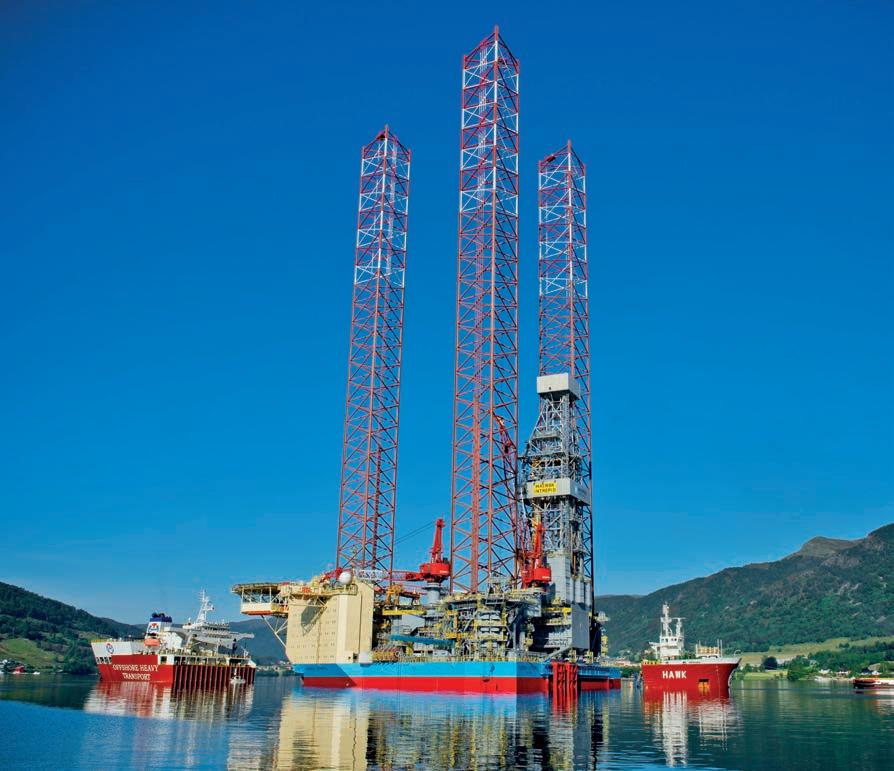
4 minute read
Low-emission rig shows promising
Maersk Intrepid is an ultra-harsh environment CJ70 jack-up rig, designed for year-round operations in the North Sea.
Photo courtesy of Maersk Drilling.
Low-emission rig shows promising emission reduction levels
AFTER SUCCESSFULLY BEING CONVERTED INTO A HYBRID, LOW-EMISSION RIG, MAERSK INTREPID HAS ENTERED OPERATIONS AS THE FIRST MAERSK DRILLING RIG TO FEATURE THIS SET OF UPGRADES.
Maersk Intrepid is currently working for Equinor on the Martn Linge feld, where the ultra-harsh environment jack-up in November this year commenced its frst drilling operaton with the full low-emission package in use.
Double-digit savings
The full technology package was expected to deliver a double-digit energy savings potental, and this has now been confrmed for Maersk Intrepid where the frst month of operatons on Martn Linge produced an inital data point of reducing fuel consumpton and CO2 emissions by approximately 25% compared to the baseline average for the rig. In additon, NOx emissions were reduced by approximately 95%, an improvement from the original target of 90%. The installaton of low-emission technology is one of several initatves supportng Maersk Drilling’s eforts to reach the company’s recently announced target of reducing its CO2 emissions intensity by 50% by 2030. Other initatves relatng to CO2 reductons include operatng rigs on shore power and partcipaton in the Project Greensand consortum, which is targetng the use of discontnued oil and gas felds for permanent storage of CO2 ofshore Denmark. “We’re thrilled to now see the full complement of low-emission technology in use on Maersk Intrepid, and to receive a very promising frst dataset on emission reductons. It’s stll too early to make any defnitve conclusions on average emission reductons over tme, but the preliminary results are very promising with reductons around 25% compared to the rig’s baseline, driven by both energy-saving technology and behavioural changes supported by the low-emission package. We want to do our part in the transiton towards a sustainable energy future, and we’re thankful for the engagement of our customer Equinor and the NOx Fund in realising this project”, says Caroline Altng, Head of Integrity & Projects at Maersk Drilling.

Exploring further initiatives
The hybrid, low-emission upgrades installed on Maersk Intrepid are supported by a grant from the Norwegian NOx Fund and by Equinor’s decision to introduce compensaton formats to stmulate emission reductons. The upgrades combine the use of hybrid power with NOx conversion units, adding data intelligence to further reduce
Low-emission upgrades on CJ70 rigs
Maersk Intrepid is an ultra-harsh environment CJ70 jack-up rig, designed for year-round operatons in the North Sea. It was delivered in 2014 and has been operatonal since. The low-emission package for Maersk Intrepid and Maersk Integrator consists of three upgrades:
1. Hybrid power – The energy use on board a rig is characterised by high peak loads during certain operatons. By installing energy storage by use of bateries, basic energy requirements can be met due to fewer engines operatng at higher intensity, supplemented by batery power, which is both more efcient and reduces CO2 and
NOx emissions. The energy storage system also allows for recovery of braking energy, adding to energy savings and further reducing emissions. 2. Energy Emission Efciency sofware – The cloud-based Energy Emission Efciency (EEE) sofware developed by Maersk Drilling uses real-tme data to monitor energy use on board the rig, which allows for contnuous optmisaton, for example by switching of engines when they are not needed. The input from the EEE system can further be used to increase focus on energy-saving behavioural changes in general. 3. SCR units to reduce NOx emissions – Selectve Catalytc Reducton (SCR) systems capture NOx exhausts and use ammonia injectons to convert the gas into harmless water and nitrogen. On Maersk Intrepid, the systems have reduced NOx emissions by approximately 95%, an improvement from the original target of 90%.
Image courtesy of Equinor.
Maersk Intrepid is currently working for Equinor on the Martin Linge feld.
energy consumpton and CO2 emissions. As part of the Master Frame Agreement between Maersk Drilling and Equinor, the partes have commited to exploring further initatves to limit greenhouse gas emissions from drilling operatons. The full package of hybrid, low-emissions upgrades is also being installed on the ultraharsh environment jack-up rig Maersk Integrator, which is expected to start operatng in full low-emission mode in Norway soon. “Maersk Drilling shows that it is technically and fnancially feasible to retroft ofshore rigs with low-emission solutons. It is also important that the ambitons do not stop there but, as in this case, the new technology paves the way for further reductons towards a zero-emission future. If Norway is to meet its natonal emission targets, it is crucial that ofshore rigs contribute with their share and with the improvements on Maersk Intrepid, Maersk Drilling is certainly showing the way. The NOx Fund is ready for more applicatons of similar character and hopes that rig operators and entrepreneurs together can develop new projects”, comments Tommy Johnsen, General Manager of the NOx Fund.










